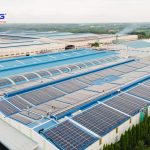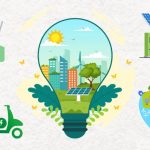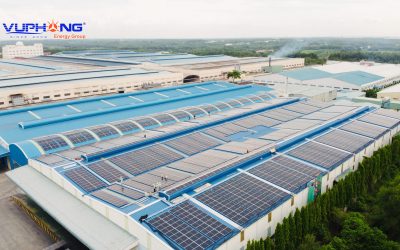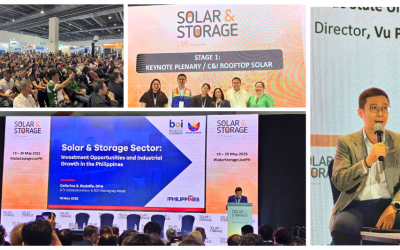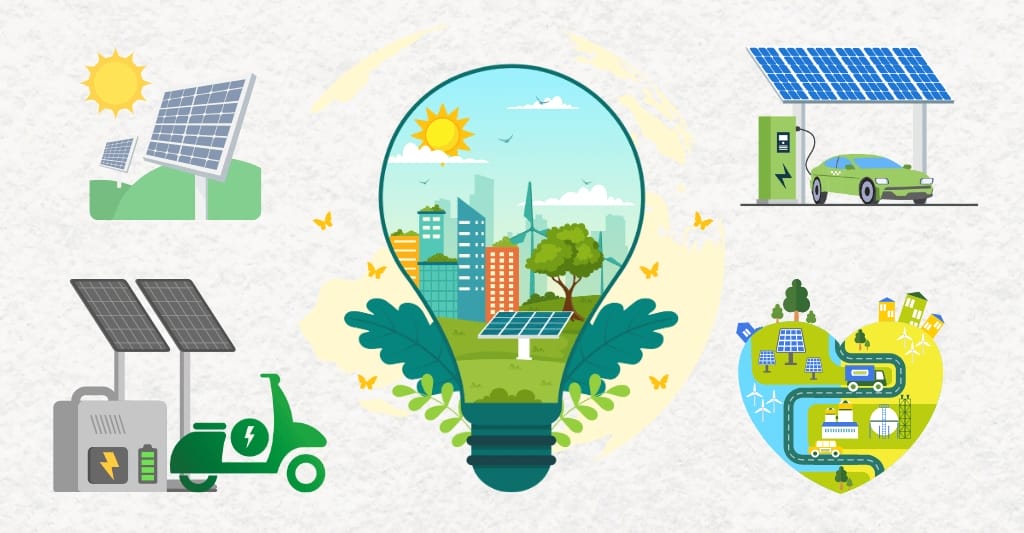
To establish a truly sustainable green transport system, green and clean energy sources must be developed. This plays a key foundational role in determining the success of the green transport transition. The close correlation between green energy and green transport not only helps significantly reduce greenhouse gas emissions but also lays a solid foundation for long-term sustainable development goals.
Vietnam’s efforts toward green transport
According to Transportation Research, the transport sector currently accounts for about 25% of global energy consumption and is one of the largest sources of greenhouse gas emissions. Cutting emissions in this sector is mandatory if countries want to fulfill their net-zero commitments by 2050.
Many countries have shifted to electric vehicles (EVs) and renewable energy (RE) to reduce pollution and carbon emissions. Norway, for example, has a thriving EV market powered largely by renewables, significantly reducing transport-related carbon emissions (MIT Climate).
 Many countries have shifted to electric vehicles (EVs)
Many countries have shifted to electric vehicles (EVs)
In Vietnam, the government is also actively promoting this transition through concrete policies. According to the World Bank (March 12, 2025), Vietnam is implementing a green transport roadmap under Decision 876/QĐ-TTg. By 2030, the goal is for 50% of urban vehicles and 100% of buses and taxis to use clean energy; by 2050, all road vehicles will switch to electricity or green energy. This roadmap emphasizes both EVs and electric motorbikes – the most common vehicle type in Vietnam, with 77 million currently in use. The government expects this transition to generate 6.5 million new jobs across the value chain by 2050.
 Demand for sustainable charging infrastructure integrated with RE when shifting into EVs
Demand for sustainable charging infrastructure integrated with RE when shifting into EVs
The rapid growth of EVs also drives demand for sustainable charging infrastructure integrated with RE. Powering EV charging stations with renewable sources not only reduces CO₂ emissions but also lowers reliance on fossil fuels, contributing to the overarching goal of achieving Net Zero by 2050. This is considered a crucial strategy for Vietnam to enhance transport efficiency while supporting the fight against climate change.
Green Transport Requires Green Energy
Green energy, also known as renewable energy, is derived from unlimited or naturally replenished resources that regenerate faster than they are consumed. Therefore, green energy acts as the supply source – the very corefor green transport to operate.
The nature of green transport
 Green transport reduces emission
Green transport reduces emission
Green transport refers to mobility methods that use clean energy and minimize harmful emissions into the environment. A green transport system must meet strict criteria such as low or zero operational carbon emissions, optimized energy consumption per kilometer, while improving air quality, reducing congestion, and lowering urban noise levels.
Green transport includes not only bicycles and personal EVs but also electric buses, urban trains, car-sharing, and bike-sharing programs. These solutions are key to modern cities’ sustainable development strategies.
The Close Correlation Between Green Transport and Green Energy
The strong link between green transport and green energy is evident in how renewables power vehicles to operate at optimal efficiency while effectively reducing CO₂ emissions. Numerous studies confirm this close relationship: when vehicles run on renewables, greenhouse gas emissions are significantly reduced while costs are saved.
A 2022 study in Case Studies in Thermal Engineering showed that when a national grid is powered 100% by renewables, electrifying transport with EVs becomes more efficient, relieves pressure on the grid, and optimizes investment costs. The study also highlighted that the optimal charging time is typically from 6:00 to 9:00 a.m – when solar production ramps up – maximizing renewable energy utilization.
In 2024, Energy Reports highlighted that integrating renewables with smart charging mechanisms could reduce grid load by up to 40% and improve charging efficiency from 70% to 95%.
 The optimal charging time is typically from 6:00 to 9:00 a.m – when solar production ramps up
The optimal charging time is typically from 6:00 to 9:00 a.m – when solar production ramps up
Solar-powered charging stations are already being deployed in many countries. For instance, in India, an 8.1 kWp solar-powered charging station served around 414 vehicles per year and reduced emissions by 7,950 kg CO₂ annually. When combined with energy storage systems, it helped cut operational costs by nearly 10% and extended system lifespan (World Electric Vehicle Journal, 2021).
Comparing EV Charging Efficiency: Renewables vs. Fossil Fuels
The efficiency gap between charging EVs with renewables versus fossil-fuel-based electricity is striking. Transportation Research notes that electrification of transport only significantly reduces emissions if powered by renewables:
- With renewables: Only 1.5 kWh of input energy (from solar, wind, etc.) is needed to generate 1 kWh of traction power at the wheels. Efficiency reaches about 67%, with 33% lost in transmission, charging, battery, and motor conversion.
- With fossil fuels: About 3.4 kWh of input energy is required to produce 1 kWh of traction power. Over 70% of energy is lost due to the inherently inefficient process of fossil-fuel power generation.
This comparison highlights the superiority of renewables in green transport—not only easing pressure on the national grid and cutting emissions, but also optimizing EV charging efficiency. Scientific studies and real-world examples clearly demonstrate that green energy is the foundation of green transport.
Practical steps toward green transport development
To develop both green transport and green energy effectively, countries – including Vietnam – must implement strong supportive policies. Common measures include tax incentives for EVs, subsidies for charging infrastructure, mandated renewable energy quotas in the grid, and clear timelines for phasing out internal combustion engine vehicles.
In Vietnam, Decision 876/QĐ-TTg (July 22, 2022) approved the national action program for green energy transition and emission reduction in the transport sector, providing a robust legal framework for green transport initiatives nationwide.
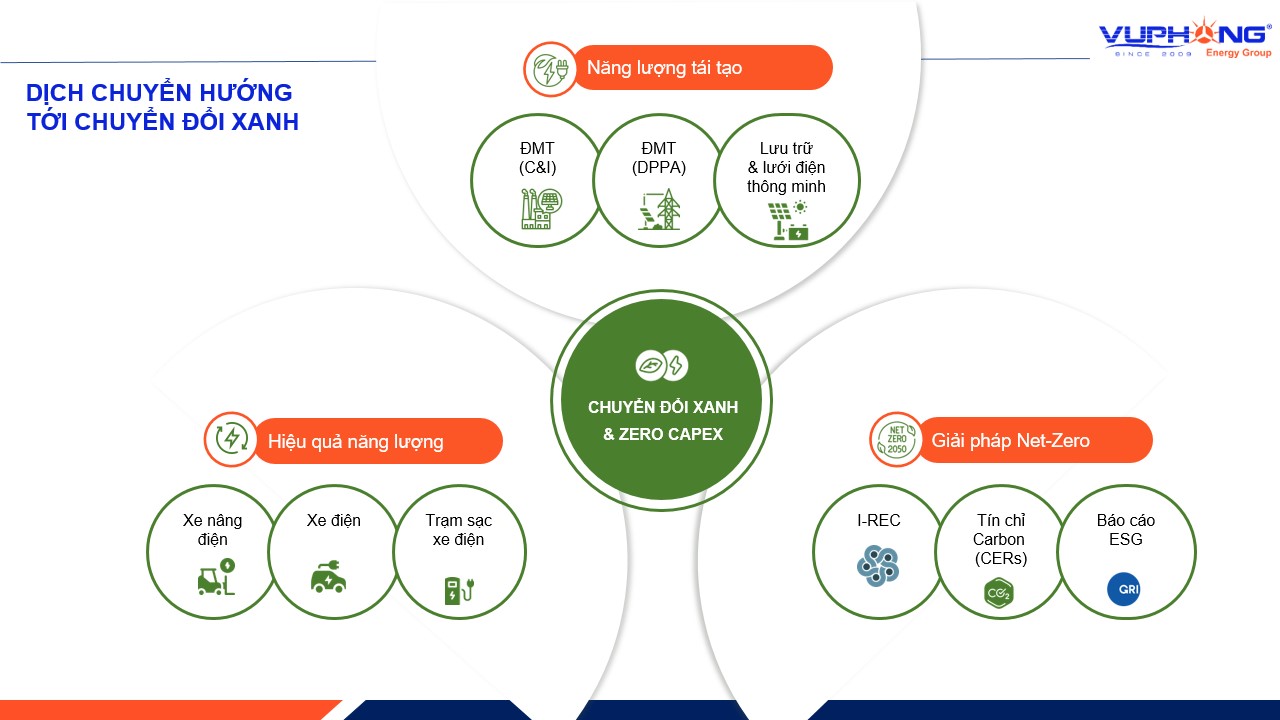 Vu Phong Energy Group is proud to be a pioneering enterprise delivering green energy solutions
Vu Phong Energy Group is proud to be a pioneering enterprise delivering green energy solutions
Vu Phong Energy Group is proud to be a pioneering enterprise delivering green energy solutions. Through the Zero Capex model, businesses and organizations can adopt clean energy at zero upfront cost. Beyond that, Vu Phong Energy Group continues to expand expertise into areas such as carbon credits, energy storage (ESS), and soon EVs and charging stations for businesses – offering cost-optimized, comprehensive solutions that ease financial pressure while enabling companies to lead in the green transition.
Source
1. Wise use of renewable energy in transport (2023). Transportation Research Part D: Transport and Environment. https://doi.org/10.1016/j.trd.2023.103713
2. MIT Climate Portal. (2022, 13 tháng 10). Are electric vehicles definitely better for the climate than gas-powered cars? MIT Climate Portal.
3. Optimal sizing of country-scale renewable energy systems towards green transportation sector in developing countries (2022). Case Studies in Thermal Engineering, 39, 102442.
4. The Future of Green Mobility: A Review Exploring Renewable Energy Systems Integration in Electric Vehicles (2025). Results in Engineering, 105647.
5. Design and Analysis of a Solar-Powered Electric Vehicle Charging Station for Indian Cities (2021). World Electric Vehicle Journal, 12(3), 132.
